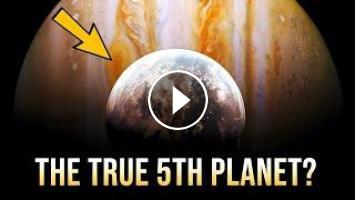The story of Phaeton is a captivating chapter in the annals of astronomy, one that embarks on a journey through the ever-evolving nature of scientific understanding. Phaeton, though ultimately disproven, left an indelible mark on the realms of science and inspiration. This hypothetical planet, believed to exist between Mars and Jupiter, served as a catalyst for exploration, imagination, and reflection on the dynamic course of human knowledge.
Phaeton's tale commences with the dawn of modern astronomy, triggered by William Herschel's discovery of Uranus in 1781. This momentous event ignited the hopes of astronomers, who sought to uncover new celestial wonders in our solar system. Amid the vast cosmic expanse, they required a guide, and the Titius-Bode law emerged as their compass. This mathematical formula proposed that planets should be located at specific distances from the Sun, a prediction that appeared to align with known celestial bodies, including the newly revealed Uranus.
Yet, the Titius-Bode law introduced an enigma: a missing planet, conspicuously absent between Mars and Jupiter. Astronomers embarked on a quest to locate this celestial void, hoping to unveil a new world in the solar system. The search bore fruit on January 1, 1801, when Giuseppe Piazzi spotted an elusive point of light in the night sky. Named Ceres, after the Roman goddess of agriculture, this discovery seemingly slotted into the mathematical framework, becoming the anticipated "missing planet."
The euphoria surrounding Ceres, however, was short-lived. Subsequent years brought the revelation of additional objects within the same orbital region, such as Pallas, Juno, and Vesta. These celestial companions shared the same orbit with Ceres, signifying that something more profound was at play. Astronomers grappled with a puzzle, oscillating between regarding these objects as planets and questioning their status.
Phaeton's story takes another intriguing twist when, in 1846, Neptune was discovered. This new planet's location did not conform to the Titius-Bode law, leading to skepticism about the formula's validity. The once-anticipated "missing planet" was fading into obscurity as a reclassification of the celestial objects within the asteroid belt took shape. Ceres, Pallas, Juno, and Vesta transitioned from planetary candidates to asteroids, establishing the asteroid belt as their domain.
The question shifted from the existence of a missing planet to the origins of the asteroid belt. Heinrich Wilhelm Olbers, who had discovered the asteroid Pallas, proposed in 1823 that these objects were remnants of a shattered planet, ushering in the Phaeton hypothesis. This fascinating theory suggested that the asteroid belt formed following the cataclysmic destruction of a planet that once orbited the Sun between Mars and Jupiter.
The name "Phaeton" was chosen, borrowing from Greek mythology and its tale of a character who rode his father's sun chariot with disastrous consequences. According to the myth, Phaeton's reckless ride led to Earth's scorching and freezing, ultimately culminating in his own destruction by a lightning bolt from Zeus.
The Phaeton hypothesis explored several scenarios for the planet's demise, including a close encounter with Jupiter, a celestial collision, interaction with a hypothetical brown dwarf, Nemesis, or an internal catastrophic event. However, as scientists delved deeper into the asteroid belt, they concluded that its total mass represented a mere 4% of the Moon's mass, rendering it incapable of forming a planet.
The asteroid belt is recognized as a relic from the solar system's formation, originating from the accretion disc surrounding the young Sun. Although Phaeton's narrative was debunked through scientific inquiry, its enduring legacy remains significant.
Phaeton's impact stretches into literature and art, serving as a symbol of curiosity and evolving knowledge. It sparks creativity in science fiction, inspiring tales of lost worlds and cosmic quests. The story embodies the dual nature of discovery and correction, a poignant reminder of the perpetual humbling of human understanding.
Phaeton's tale reflects humanity's curiosity, emphasizing the importance of bold hypotheses and their scrutiny in scientific advancement. It symbolizes our relentless pursuit of knowledge, urging us to challenge norms, explore the cosmos, and embrace its mysteries with unwavering curiosity.
#SpaceOdyssey
#Phaeton
#Astronomy
#SolarSystem
#CosmicMysteries
#ScientificDiscovery
#AsteroidBelt
#ScienceFiction
#SpaceExploration
#PlanetaryFormation
#Hypothesis
#TitiusBodeLaw
#CelestialObjects
#SpaceScience
#SolarSystemHistory
#PlanetHunting
#ScienceAndImagination
#UniverseExploration
#PlanetPhaeton
#AstronomyHistory
#AstronomicalDiscoveries
#SolarSystemOrigins
#ScienceNarrative
#PhaetonLegacy
#CosmicQuest
#ImaginativeScience
#SpaceCuriosity
#LostPlanets
#PlanetaryTheories
#ScientificJourney
#ExploringTheUnknown
Phaeton's tale commences with the dawn of modern astronomy, triggered by William Herschel's discovery of Uranus in 1781. This momentous event ignited the hopes of astronomers, who sought to uncover new celestial wonders in our solar system. Amid the vast cosmic expanse, they required a guide, and the Titius-Bode law emerged as their compass. This mathematical formula proposed that planets should be located at specific distances from the Sun, a prediction that appeared to align with known celestial bodies, including the newly revealed Uranus.
Yet, the Titius-Bode law introduced an enigma: a missing planet, conspicuously absent between Mars and Jupiter. Astronomers embarked on a quest to locate this celestial void, hoping to unveil a new world in the solar system. The search bore fruit on January 1, 1801, when Giuseppe Piazzi spotted an elusive point of light in the night sky. Named Ceres, after the Roman goddess of agriculture, this discovery seemingly slotted into the mathematical framework, becoming the anticipated "missing planet."
The euphoria surrounding Ceres, however, was short-lived. Subsequent years brought the revelation of additional objects within the same orbital region, such as Pallas, Juno, and Vesta. These celestial companions shared the same orbit with Ceres, signifying that something more profound was at play. Astronomers grappled with a puzzle, oscillating between regarding these objects as planets and questioning their status.
Phaeton's story takes another intriguing twist when, in 1846, Neptune was discovered. This new planet's location did not conform to the Titius-Bode law, leading to skepticism about the formula's validity. The once-anticipated "missing planet" was fading into obscurity as a reclassification of the celestial objects within the asteroid belt took shape. Ceres, Pallas, Juno, and Vesta transitioned from planetary candidates to asteroids, establishing the asteroid belt as their domain.
The question shifted from the existence of a missing planet to the origins of the asteroid belt. Heinrich Wilhelm Olbers, who had discovered the asteroid Pallas, proposed in 1823 that these objects were remnants of a shattered planet, ushering in the Phaeton hypothesis. This fascinating theory suggested that the asteroid belt formed following the cataclysmic destruction of a planet that once orbited the Sun between Mars and Jupiter.
The name "Phaeton" was chosen, borrowing from Greek mythology and its tale of a character who rode his father's sun chariot with disastrous consequences. According to the myth, Phaeton's reckless ride led to Earth's scorching and freezing, ultimately culminating in his own destruction by a lightning bolt from Zeus.
The Phaeton hypothesis explored several scenarios for the planet's demise, including a close encounter with Jupiter, a celestial collision, interaction with a hypothetical brown dwarf, Nemesis, or an internal catastrophic event. However, as scientists delved deeper into the asteroid belt, they concluded that its total mass represented a mere 4% of the Moon's mass, rendering it incapable of forming a planet.
The asteroid belt is recognized as a relic from the solar system's formation, originating from the accretion disc surrounding the young Sun. Although Phaeton's narrative was debunked through scientific inquiry, its enduring legacy remains significant.
Phaeton's impact stretches into literature and art, serving as a symbol of curiosity and evolving knowledge. It sparks creativity in science fiction, inspiring tales of lost worlds and cosmic quests. The story embodies the dual nature of discovery and correction, a poignant reminder of the perpetual humbling of human understanding.
Phaeton's tale reflects humanity's curiosity, emphasizing the importance of bold hypotheses and their scrutiny in scientific advancement. It symbolizes our relentless pursuit of knowledge, urging us to challenge norms, explore the cosmos, and embrace its mysteries with unwavering curiosity.
#SpaceOdyssey
#Phaeton
#Astronomy
#SolarSystem
#CosmicMysteries
#ScientificDiscovery
#AsteroidBelt
#ScienceFiction
#SpaceExploration
#PlanetaryFormation
#Hypothesis
#TitiusBodeLaw
#CelestialObjects
#SpaceScience
#SolarSystemHistory
#PlanetHunting
#ScienceAndImagination
#UniverseExploration
#PlanetPhaeton
#AstronomyHistory
#AstronomicalDiscoveries
#SolarSystemOrigins
#ScienceNarrative
#PhaetonLegacy
#CosmicQuest
#ImaginativeScience
#SpaceCuriosity
#LostPlanets
#PlanetaryTheories
#ScientificJourney
#ExploringTheUnknown
- Catégories
- Location saisonnière Location



















Commentaires